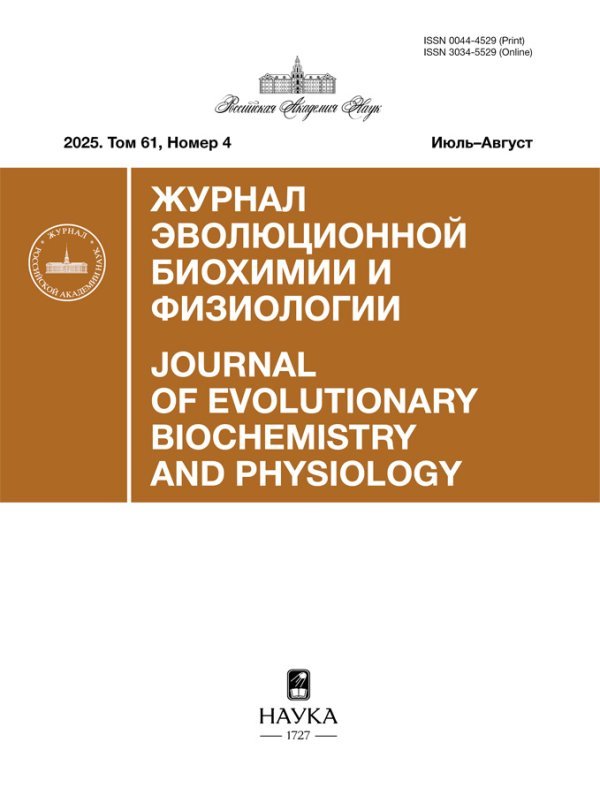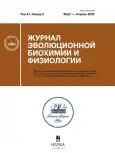Structural and cytochemical features of the process of formation of innervation of the airways and lungs of the rat
- Authors: Chumasov E.I.1,2, Petrova E.S.1, Korzhevskii D.E.1
-
Affiliations:
- Institute of Experimental Medicine
- St. Petersburg State University of Veterinary Medicine
- Issue: Vol 61, No 2 (2025)
- Pages: 97-107
- Section: EXPERIMENTAL ARTICLES
- URL: https://edgccjournal.org/0044-4529/article/view/685050
- DOI: https://doi.org/10.31857/S0044452925020033
- EDN: https://elibrary.ru/IEVTRC
- ID: 685050
Cite item
Abstract
The aim of the work is to study the development of the nervous apparatus and muscle structures of the rat lung in the early stages of postnatal development. The objects of study were extramural and intramural parts of the lung (trachea, main bronchi and lobar parts of the lung, including the respiratory section) of Wistar rats aged from one to fourteen days. Nervous structures were studied using immunohistochemical markers: PGP 9.5 protein, tyrosine hydroxylase, synaptophysin. Sarcomeric actin was used to identify muscle cells. It was found that in newborn rats, the distribution density of cholinergic structures (parasympathetic ganglia, microganglia of the nerve plexuses and terminal synaptic networks) prevails over catecholaminergic (sympathetic neurons and bundles of postganglionic fibers). Ganglionic plexuses are located around the trachea and main bronchi. Changes in tissue innervation in the bronchial wall of the lung in the cranio-caudal direction were detected. High density of distribution of nerve plexuses is characteristic of the proximal sections. They are absent in the alveolar regions. Close relationships of the main terminal nerve plexus with muscle tissue cells of the bronchial wall of different calibers up to the bronchioles are shown. Low innervation of cellular elements in the lobules around the pulmonary sacs and the absence of nerve terminals in the interalveolar septa are noted. Using the reaction to the S100β protein, cellular elements morphologically similar to the glial cells of Cajal, without axons included in their cytoplasm, were revealed in these places. An important feature is noted: the presence of cardiomyocytes in the muscular wall of the main pulmonary veins of the mediastinum and the cranial section of the lung. In the alveolar parts of the lungs, the wall of the pulmonary vein consists of smooth myocytes and the sphincters formed by them. The issues of differences in the histological structure and innervation of the afferent, efferent and exchange arterial and venous vessels of the microcirculatory bed of the lung require further special study. The absence of broncho-associated lymphoid tissue, characteristic of sexually mature animals, in the studied material at early stages of development was noted. The synchronicity of the formation of interneuronal and neuromuscular synapses, which are important for regulating the onset of the respiratory process in animals, was established.
Full Text
About the authors
E. I. Chumasov
Institute of Experimental Medicine; St. Petersburg State University of Veterinary Medicine
Author for correspondence.
Email: ua1сt@mail.ru
Russian Federation, St. Petersburg; St. Petersburg
E. S. Petrova
Institute of Experimental Medicine
Email: ua1сt@mail.ru
Russian Federation, St. Petersburg
D. E. Korzhevskii
Institute of Experimental Medicine
Email: ua1сt@mail.ru
Russian Federation, St. Petersburg
References
- Кошевая ЕГ, Данилова ИА, Сидорин ВС, Моисеева ОМ, Митрофанова ЛБ (2022) Иммуногистохимическое исследование экспрессии белков экстрацеллюлярного матрикса и иннервации легких у пациентов с легочной артериальной гипертензией. Артер гипертенз 28(2): 198–210. https://doi.org/10.18705/1607-419X-2022-28-2-198-210
- Имнадзе ГГ, Серов РА, Ревишвили АШ (2004) Морфология легочных вен и их мышечных муфт, роль в возникновении фибрилляции предсердий. Вестн Аритмологии 34: 44–49.
- Mortola JP, Marghescu D, Siegrist-Johnstone R, Matthes E (2020) Respiratory sinus arrhythmia during a mental attention task: the role of breathing-specific heart rate. Respirat Physiol Neurobiol 272: 103331. https://doi.org/10.1016/J.Resp.2019.103331
- Филиппова ЛВ, Ноздрачев АД (2013) Сенсорные структуры легких и воздухоносных путей. Усп. Физиол. наук 44 (3): 93–112.
- Шемяков СЕ, Федосов АА (2024) Анатомия и гистология легких / В кн.: Респираторная медицина: руководство: в 4 т. / под ред. А. Г. Чучалина. — 3-е изд., доп. и перераб. — Москва: ПульмоМедиа 1: 18–47.
- Чумасов ЕИ, Ворончихин ПА, Коржевский ДЭ (2011) Иннервация сердечной поперечнополосатой мышечной ткани легочных вен крысы. Морфология 140(6): 53–55.
- Чумасов ЕИ, Ворончихин ПА, Коржевский ДЭ (2012) Эфферентная иннервация сосудов и бронхов легкого крысы (иммуногистохимическое исследование). Морфология 142(4): 49–53.
- Чумасов ЕИ, Колос ЕА, Петрова ЕС, Коржевский ДЭ (2020) Иммуногистохимия периферической нервной системы. СПб.: СпецЛит.
- Weichselbaum M, Sparrow MP (1999) A confocal microscopic study of the formation of ganglia in the airways of fetal pig lung. Am J Respir Cell Mol Biol 21(5): 607–620. https://doi.org/ 10.1165/ajrcmb.21.5.3721
- Sparrow MP, Weichselbaum M, McCray PB (1999) Development of the innervations and airway smooth muscle in human fetal lung. Am J Respir Cell Mol Biol 21(55): 607–620.
- Целуйко СС, Гордиенко ЕН, Колесников СИ (2014) Сравнительный морфометрический анализ паренхимы легкого крыс на этапе позднего эмбриогенеза. Дальневосточн. Мед. Журн. 2: 71–75.
- Schittny JC (2017) Development of the lung. Cell Tissue Res 367(3): 427–444. https://doi.org/10.1007/s00441-016-2545-0
- Haley KJ, Drazen JM, Osathanondh R, Sunday ME (1997) Comparison of the ontogeny of protein gene product 9.5, chromographin A and proliferating cell nuclear antigen in developing human lung. Microsc Res Tech 37: 62–68.
- Sparrow MP, Lamb JP (2003) Ontogeny of airway smooth muscle: structure, innervation, myogenesis and function in the fetal lung. Respirat Physiol Neurobiol 137(2-3: 361–372. https://doi.org/10.1016/s1569-9048(03)00159-9
- Grigorev IP, Korzhevskii DE (2018) Current technologies for fixation of biological material for immunohistochemical analysis (review). Modern Technol Med 10(2): 156–165. https://doi.org/10.17691/stm2018.10.2.19
- Polak JM, Bloom SR (2004) Regulatory peptides and neuron-specific enolase in the respiratory tract of man and other mammals. Exp Lung Res 1982 3(3–4): 313–328. https://doi.org/10.3109/01902148209069660
- Cavallotti C, Tonnarini GF, Tranquilli Leali FM (2004) Cholinergic innervation of BALT (bronchus associated lymphoid tissue) in rat. Lung 182(1): 27–35. https://doi.org/10.1007/s00408-003-1042-x.
- Sparrow MP, Warwick SP, Everett AW (1995) Innervation and function of the distal airways in the developing bronchial tree of fetal pig lung. Am J Respir Cell Mol Biol 13(5): 518–525. https://doi.org/10.1165/ajrcmb.13.5.7576686
- Блинова СА, Юлдашева НБ, Хотамова ГБ (2021) Вегетативная иннервация легких в постнатальном онтогенезе. Вопр. наук образ. 19 (144): 52–57.
- Shurin MR, Wheeler SE, Shurin GV, Zhong H, Zhou Y (2024) Schwann cells in the normal and pathological lung microenvironment. Front Mol Biosci 11:1365760. https://doi.org/ 10.3389/fmolb.2024.1365760
- Rumessen JJ, Mikkelsen HB, Qvortrup K, Thuneberg L (1993) Ultrastructure of interstitial cells of Cajal in circular muscle of human small intestine. Gastroenterology 104 (2): 343–350.
- Лаврентьев БИ (1983) Теория строения вегетативной нервной системы. М.: Медицина.
- Gabella G (2022) Enteric glia: Extent, cohesion, axonal contacts, membrane separations and mitochondria in Auerbach’s ganglia of guinea pigs. Cell Tissue Res 389(3): 409–426. https://doi.org/ 10.1007/s00441-022-03656-3
- Rumessen JJ, Vanderwinden JM, Horn T (2010) Ulcerative colitis: ultrastructure of interstitial cells in myenteric plexus. Ultrastruct Pathol. 34(5): 279-287. https://doi.org/10.3109/01913121003770701.
- Furness JB, Stebbing MJ (2018) The first brain: Species comparisons and evolutionary implications for the enteric and central nervous systems. Neurogastroenterol Motil 30(2). https://doi.org/ 10.1111/nmo.13234
- Sander KM, Ward SM, Koh SD (2014) Interstitial cells Regulatiors of smooth muscle function. Physiol Rev 94: 859–907.
- Артюхина ЕА, Кузнецов НМ, Васковский ВА, Яшков МВ, Дедух ЕВ, Таймасова ИА, Ревишвили АШ (2023) Сравнение эффективности криобаллонной и комбинированной методик изоляции легочных вен у пациентов с пароксизмальной формой фибрилляции предсердий: интраоперационные и госпитальные результаты. Диагностич. Интервенцион. Радиол. 17(1): 25–33.
- Шиленко ЛА, Чепурной ЗИ, Маметов МВ, Воротилов АВ, Мухина АА, Шиленко А А., Ваулина ДД, Смирнов СС, Карпов АА (2022) Иннервация сосудов малого круга кровообращения в норме и при легочной гипертензии. Универс. Тер. Вестн. 3(4): 40–52.
Supplementary files


















